Chen Ling
M2SE: A Multistage Multitask Instruction Tuning Strategy for Unified Sentiment and Emotion Analysis
Dec 11, 2024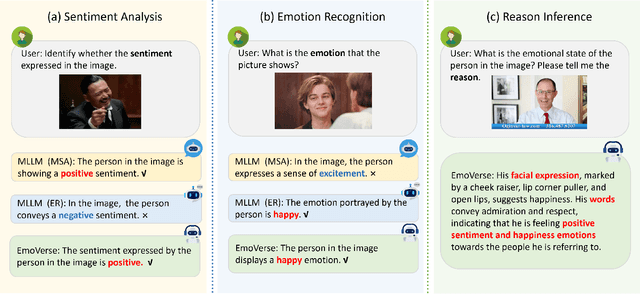
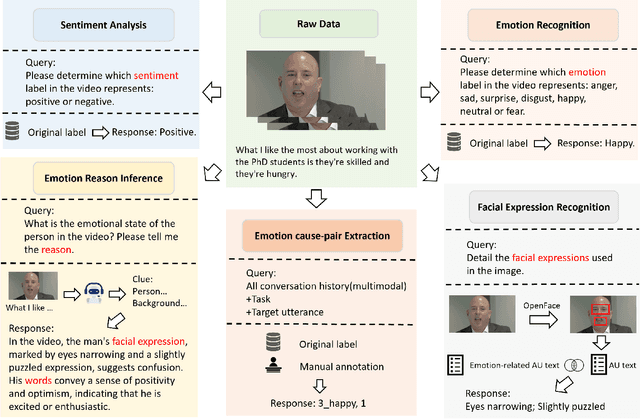


Abstract:Sentiment analysis and emotion recognition are crucial for applications such as human-computer interaction and depression detection. Traditional unimodal methods often fail to capture the complexity of emotional expressions due to conflicting signals from different modalities. Current Multimodal Large Language Models (MLLMs) also face challenges in detecting subtle facial expressions and addressing a wide range of emotion-related tasks. To tackle these issues, we propose M2SE, a Multistage Multitask Sentiment and Emotion Instruction Tuning Strategy for general-purpose MLLMs. It employs a combined approach to train models on tasks such as multimodal sentiment analysis, emotion recognition, facial expression recognition, emotion reason inference, and emotion cause-pair extraction. We also introduce the Emotion Multitask dataset (EMT), a custom dataset that supports these five tasks. Our model, Emotion Universe (EmoVerse), is built on a basic MLLM framework without modifications, yet it achieves substantial improvements across these tasks when trained with the M2SE strategy. Extensive experiments demonstrate that EmoVerse outperforms existing methods, achieving state-of-the-art results in sentiment and emotion tasks. These results highlight the effectiveness of M2SE in enhancing multimodal emotion perception. The dataset and code are available at https://github.com/xiaoyaoxinyi/M2SE.
Enhancing Security Control Production With Generative AI
Nov 06, 2024Abstract:Security controls are mechanisms or policies designed for cloud based services to reduce risk, protect information, and ensure compliance with security regulations. The development of security controls is traditionally a labor-intensive and time-consuming process. This paper explores the use of Generative AI to accelerate the generation of security controls. We specifically focus on generating Gherkin codes which are the domain-specific language used to define the behavior of security controls in a structured and understandable format. By leveraging large language models and in-context learning, we propose a structured framework that reduces the time required for developing security controls from 2-3 days to less than one minute. Our approach integrates detailed task descriptions, step-by-step instructions, and retrieval-augmented generation to enhance the accuracy and efficiency of the generated Gherkin code. Initial evaluations on AWS cloud services demonstrate promising results, indicating that GenAI can effectively streamline the security control development process, thus providing a robust and dynamic safeguard for cloud-based infrastructures.
HiReview: Hierarchical Taxonomy-Driven Automatic Literature Review Generation
Oct 02, 2024Abstract:In this work, we present HiReview, a novel framework for hierarchical taxonomy-driven automatic literature review generation. With the exponential growth of academic documents, manual literature reviews have become increasingly labor-intensive and time-consuming, while traditional summarization models struggle to generate comprehensive document reviews effectively. Large language models (LLMs), with their powerful text processing capabilities, offer a potential solution; however, research on incorporating LLMs for automatic document generation remains limited. To address key challenges in large-scale automatic literature review generation (LRG), we propose a two-stage taxonomy-then-generation approach that combines graph-based hierarchical clustering with retrieval-augmented LLMs. First, we retrieve the most relevant sub-community within the citation network, then generate a hierarchical taxonomy tree by clustering papers based on both textual content and citation relationships. In the second stage, an LLM generates coherent and contextually accurate summaries for clusters or topics at each hierarchical level, ensuring comprehensive coverage and logical organization of the literature. Extensive experiments demonstrate that HiReview significantly outperforms state-of-the-art methods, achieving superior hierarchical organization, content relevance, and factual accuracy in automatic literature review generation tasks.
PIXELMOD: Improving Soft Moderation of Visual Misleading Information on Twitter
Jul 30, 2024Abstract:Images are a powerful and immediate vehicle to carry misleading or outright false messages, yet identifying image-based misinformation at scale poses unique challenges. In this paper, we present PIXELMOD, a system that leverages perceptual hashes, vector databases, and optical character recognition (OCR) to efficiently identify images that are candidates to receive soft moderation labels on Twitter. We show that PIXELMOD outperforms existing image similarity approaches when applied to soft moderation, with negligible performance overhead. We then test PIXELMOD on a dataset of tweets surrounding the 2020 US Presidential Election, and find that it is able to identify visually misleading images that are candidates for soft moderation with 0.99% false detection and 2.06% false negatives.
TEG-DB: A Comprehensive Dataset and Benchmark of Textual-Edge Graphs
Jun 14, 2024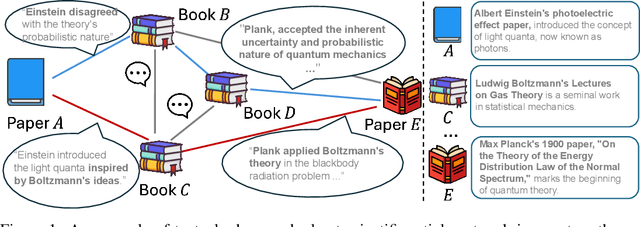
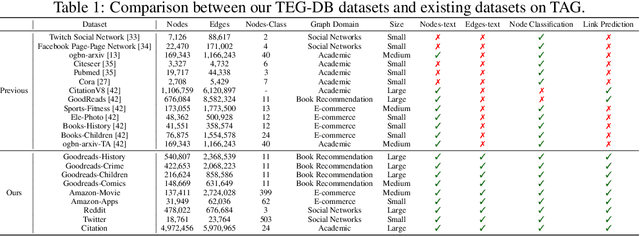
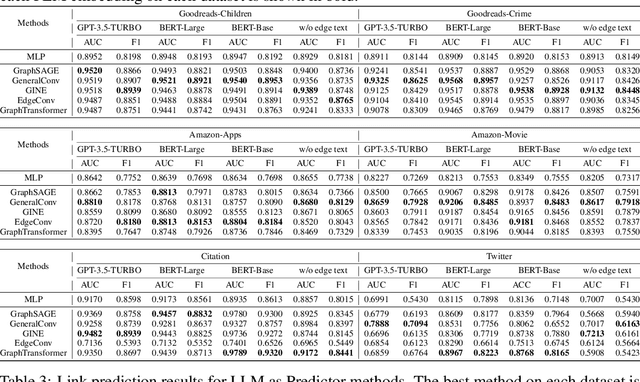
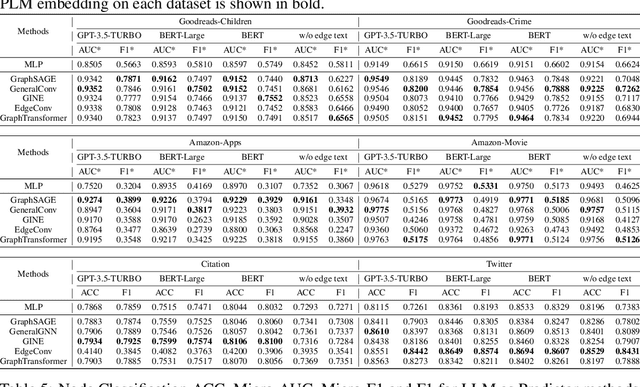
Abstract:Text-Attributed Graphs (TAGs) augment graph structures with natural language descriptions, facilitating detailed depictions of data and their interconnections across various real-world settings. However, existing TAG datasets predominantly feature textual information only at the nodes, with edges typically represented by mere binary or categorical attributes. This lack of rich textual edge annotations significantly limits the exploration of contextual relationships between entities, hindering deeper insights into graph-structured data. To address this gap, we introduce Textual-Edge Graphs Datasets and Benchmark (TEG-DB), a comprehensive and diverse collection of benchmark textual-edge datasets featuring rich textual descriptions on nodes and edges. The TEG-DB datasets are large-scale and encompass a wide range of domains, from citation networks to social networks. In addition, we conduct extensive benchmark experiments on TEG-DB to assess the extent to which current techniques, including pre-trained language models, graph neural networks, and their combinations, can utilize textual node and edge information. Our goal is to elicit advancements in textual-edge graph research, specifically in developing methodologies that exploit rich textual node and edge descriptions to enhance graph analysis and provide deeper insights into complex real-world networks. The entire TEG-DB project is publicly accessible as an open-source repository on Github, accessible at https://github.com/Zhuofeng-Li/TEG-Benchmark.
TAGA: Text-Attributed Graph Self-Supervised Learning by Synergizing Graph and Text Mutual Transformations
May 27, 2024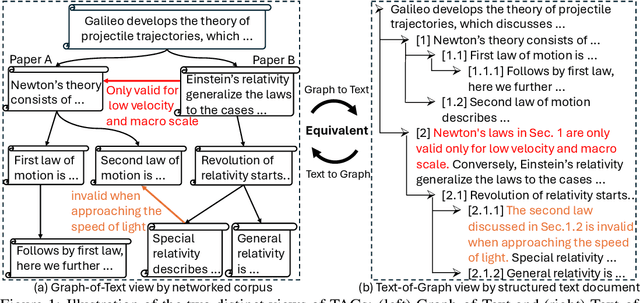
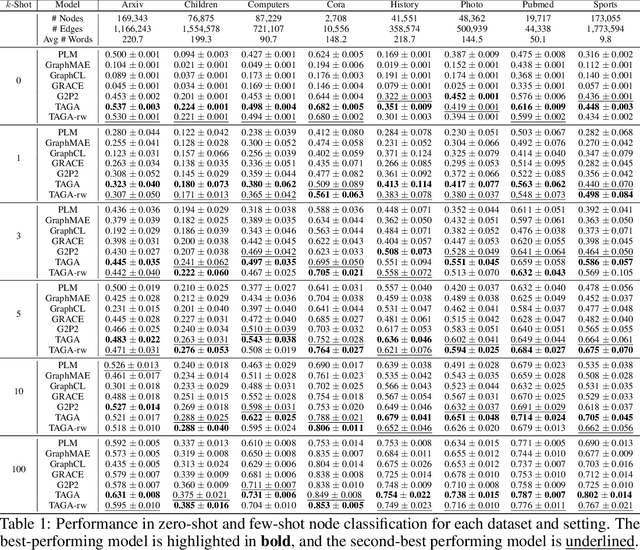
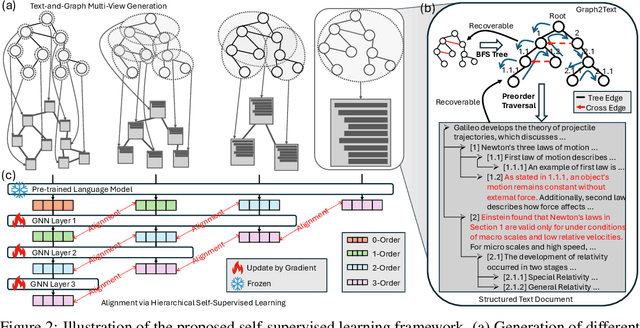
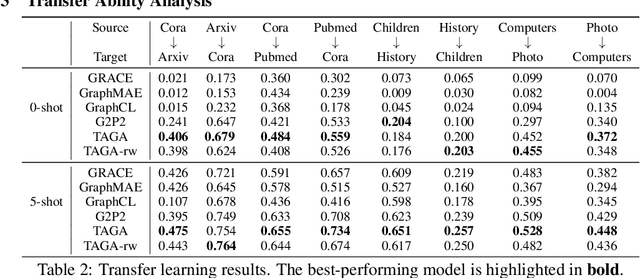
Abstract:Text-Attributed Graphs (TAGs) enhance graph structures with natural language descriptions, enabling detailed representation of data and their relationships across a broad spectrum of real-world scenarios. Despite the potential for deeper insights, existing TAG representation learning primarily relies on supervised methods, necessitating extensive labeled data and limiting applicability across diverse contexts. This paper introduces a new self-supervised learning framework, Text-And-Graph Multi-View Alignment (TAGA), which overcomes these constraints by integrating TAGs' structural and semantic dimensions. TAGA constructs two complementary views: Text-of-Graph view, which organizes node texts into structured documents based on graph topology, and the Graph-of-Text view, which converts textual nodes and connections into graph data. By aligning representations from both views, TAGA captures joint textual and structural information. In addition, a novel structure-preserving random walk algorithm is proposed for efficient training on large-sized TAGs. Our framework demonstrates strong performance in zero-shot and few-shot scenarios across eight real-world datasets.
GRAG: Graph Retrieval-Augmented Generation
May 26, 2024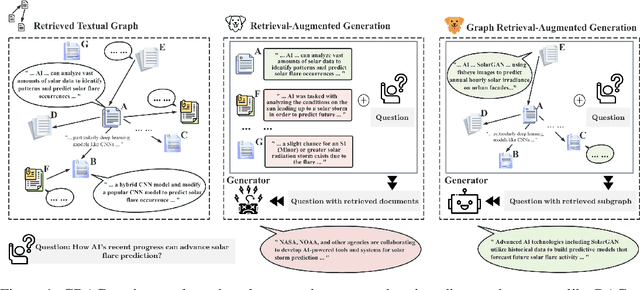
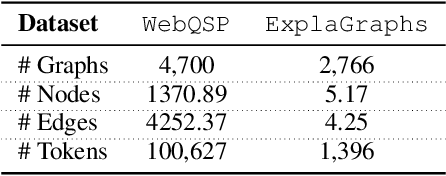
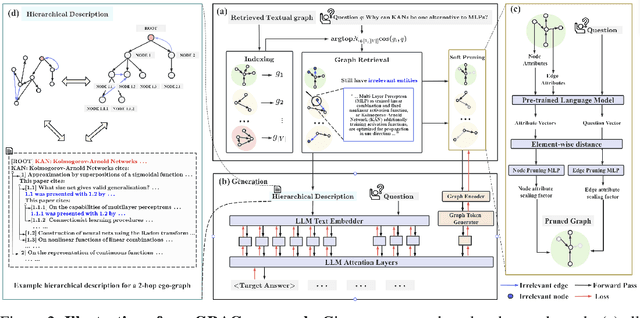
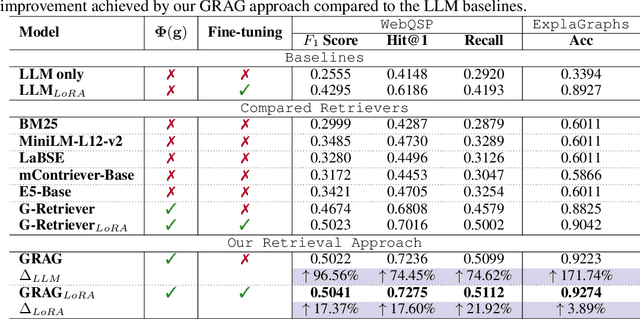
Abstract:While Retrieval-Augmented Generation (RAG) enhances the accuracy and relevance of responses by generative language models, it falls short in graph-based contexts where both textual and topological information are important. Naive RAG approaches inherently neglect the structural intricacies of textual graphs, resulting in a critical gap in the generation process. To address this challenge, we introduce $\textbf{Graph Retrieval-Augmented Generation (GRAG)}$, which significantly enhances both the retrieval and generation processes by emphasizing the importance of subgraph structures. Unlike RAG approaches that focus solely on text-based entity retrieval, GRAG maintains an acute awareness of graph topology, which is crucial for generating contextually and factually coherent responses. Our GRAG approach consists of four main stages: indexing of $k$-hop ego-graphs, graph retrieval, soft pruning to mitigate the impact of irrelevant entities, and generation with pruned textual subgraphs. GRAG's core workflow-retrieving textual subgraphs followed by soft pruning-efficiently identifies relevant subgraph structures while avoiding the computational infeasibility typical of exhaustive subgraph searches, which are NP-hard. Moreover, we propose a novel prompting strategy that achieves lossless conversion from textual subgraphs to hierarchical text descriptions. Extensive experiments on graph multi-hop reasoning benchmarks demonstrate that in scenarios requiring multi-hop reasoning on textual graphs, our GRAG approach significantly outperforms current state-of-the-art RAG methods while effectively mitigating hallucinations.
MIM-Reasoner: Learning with Theoretical Guarantees for Multiplex Influence Maximization
Mar 10, 2024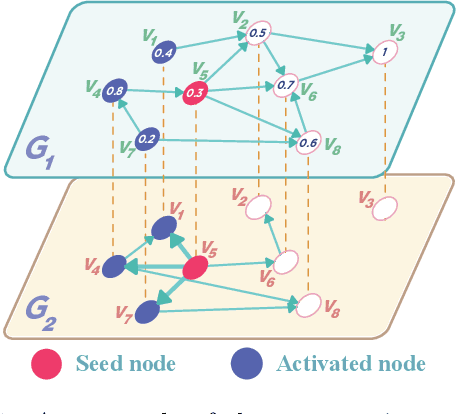

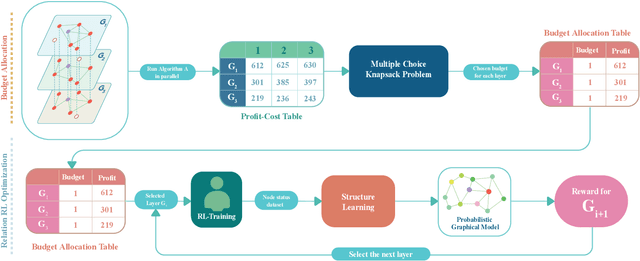
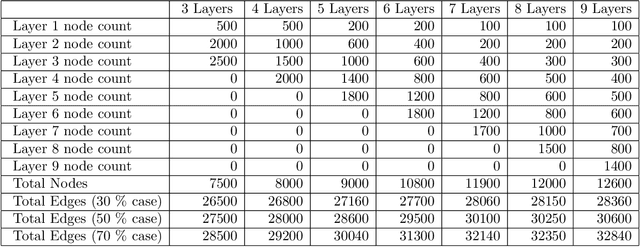
Abstract:Multiplex influence maximization (MIM) asks us to identify a set of seed users such as to maximize the expected number of influenced users in a multiplex network. MIM has been one of central research topics, especially in nowadays social networking landscape where users participate in multiple online social networks (OSNs) and their influences can propagate among several OSNs simultaneously. Although there exist a couple combinatorial algorithms to MIM, learning-based solutions have been desired due to its generalization ability to heterogeneous networks and their diversified propagation characteristics. In this paper, we introduce MIM-Reasoner, coupling reinforcement learning with probabilistic graphical model, which effectively captures the complex propagation process within and between layers of a given multiplex network, thereby tackling the most challenging problem in MIM. We establish a theoretical guarantee for MIM-Reasoner as well as conduct extensive analyses on both synthetic and real-world datasets to validate our MIM-Reasoner's performance.
Gradient-Free Adaptive Global Pruning for Pre-trained Language Models
Feb 28, 2024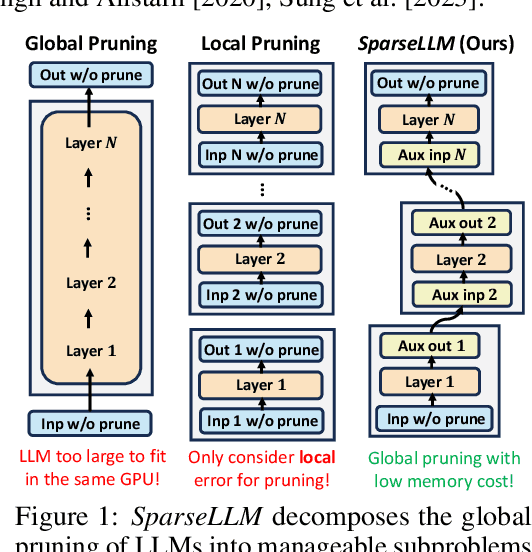
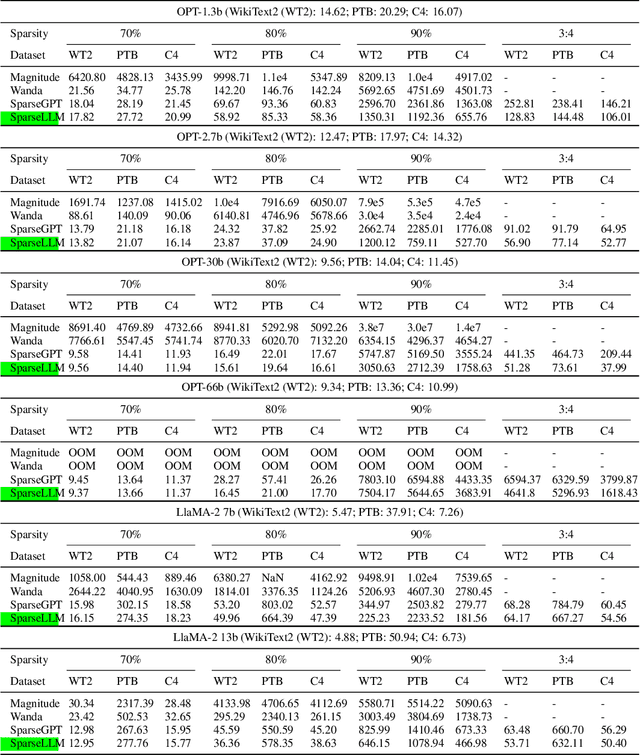
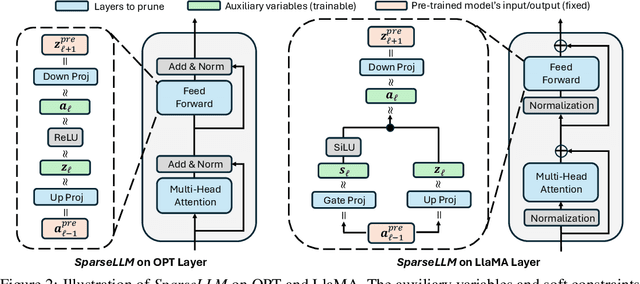
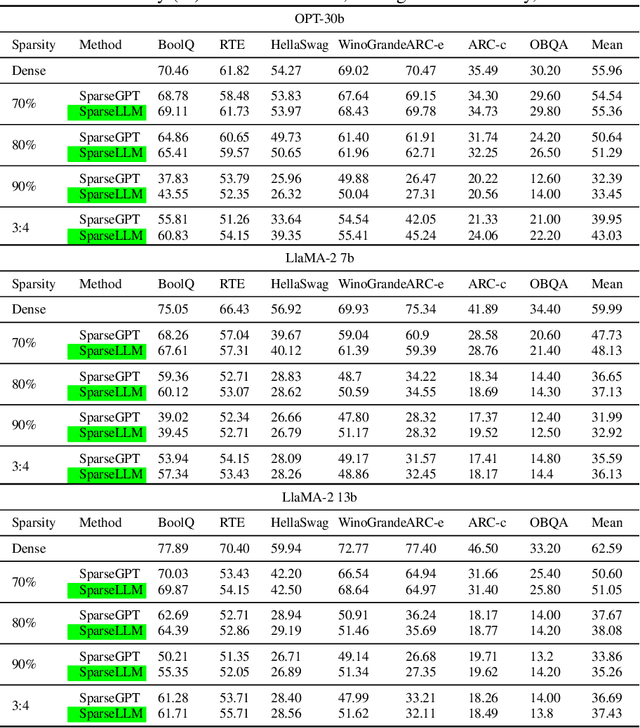
Abstract:The transformative impact of large language models (LLMs) like LLaMA and GPT on natural language processing is countered by their prohibitive computational demands. Pruning has emerged as a pivotal compression strategy, introducing sparsity to enhance both memory and computational efficiency. Yet, traditional global pruning is impractical for LLMs due to scalability issues, while local pruning, despite its efficiency, leads to suboptimal solutions. Addressing these challenges, we propose Adaptive Global Pruning (AdaGP), a novel framework that redefines the global pruning process into manageable, coordinated subproblems, allowing for resource-efficient optimization with global optimality. AdaGP's approach, which conceptualizes LLMs as a chain of modular functions and leverages auxiliary variables for problem decomposition, not only facilitates a pragmatic application on LLMs but also demonstrates significant performance improvements, particularly in high-sparsity regimes where it surpasses current state-of-the-art methods.
ELAD: Explanation-Guided Large Language Models Active Distillation
Feb 20, 2024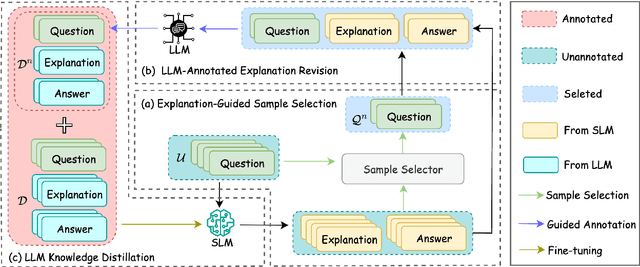
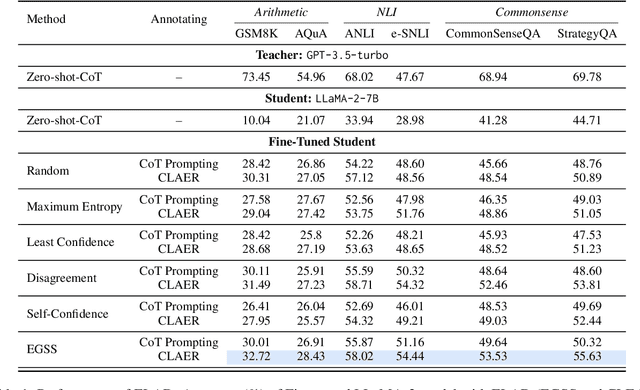


Abstract:The deployment and application of Large Language Models (LLMs) is hindered by their memory inefficiency, computational demands, and the high costs of API inferences. Traditional distillation methods, which transfer the capabilities of LLMs to smaller models, often fail to determine whether the knowledge has been sufficiently transferred, potentially resulting in high costs or incomplete distillation. In this paper, we propose an Explanation-Guided LLMs Active Distillation (ELAD) framework that employs an active learning strategy to optimize the balance between annotation costs and model performance. To improve efficient sample selection, we introduce an explanation-guided sample selection method that identifies samples challenging its reasoning by exploiting uncertainties in explanation steps. Additionally, we present a customized LLM-annotated explanation revision technique where the teacher model detects and corrects flaws in the student model's reasoning. Our experiments across various reasoning datasets demonstrate that our framework significantly enhances the efficiency of LLM knowledge distillation.
 Add to Chrome
Add to Chrome Add to Firefox
Add to Firefox Add to Edge
Add to Edge